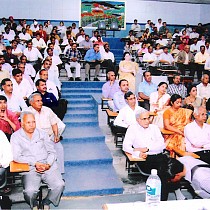INTEGRATED PEST MANAGEMENT (IPM) IN PUNJAB – REPERCUSSIONS ON INSECT-PEST INCIDENCE, NATURAL ENEMIES AND COTTON YIELD
Department of Entomology, Punjab Agricultural University, Ludhiana
A.K. DHAWAN, ANAND ANEJA, JASBIR SINGH AND VIJAY KUMAR
To manage the problems arising from the excessive use of pesticides for the control of insect-pests on cotton, IPM
strategies were disseminated among cotton growers of 8 villages of Punjab during 2008. It included cultivation of recommended tolerant varieties to bollworms, no spray from sowing to first week of July, use of recommended insecticides on ETL from second week of July to first week of August and eradication of weeds for the management of mealy bug. The farmers weretrained in identification of insect pests, time of selection of pesticide and insect economic threshold levels. Four cottongrowing districts i.e. Mansa, Muktsar, Ferozepur and Bathinda were covered under this programme. Non-IPM villages were also kept for ascertaining the impact of adopted strategy. The mean number of jassid nymphs/three leaves and whitely adults/three leaves were low in IPM villages (0.34 and 0.46) as compared to non-IPM villages (0.91 and 0.95) during crop season. The population of natural enemies during early season remained high in cotton crop due to less number of sprays and thus helped in reducing the pest population and ultimately the damage done by these pests. The impact of adoption of IPM strategies resulted in 37.31 per cent reduction in number of sprays in IPM villages over non-IPM villages. The average net profit per hectare was more in IPM villages (Rs. 48402/ha) as compared to non-IPM villages (Rs. 3309/h).


